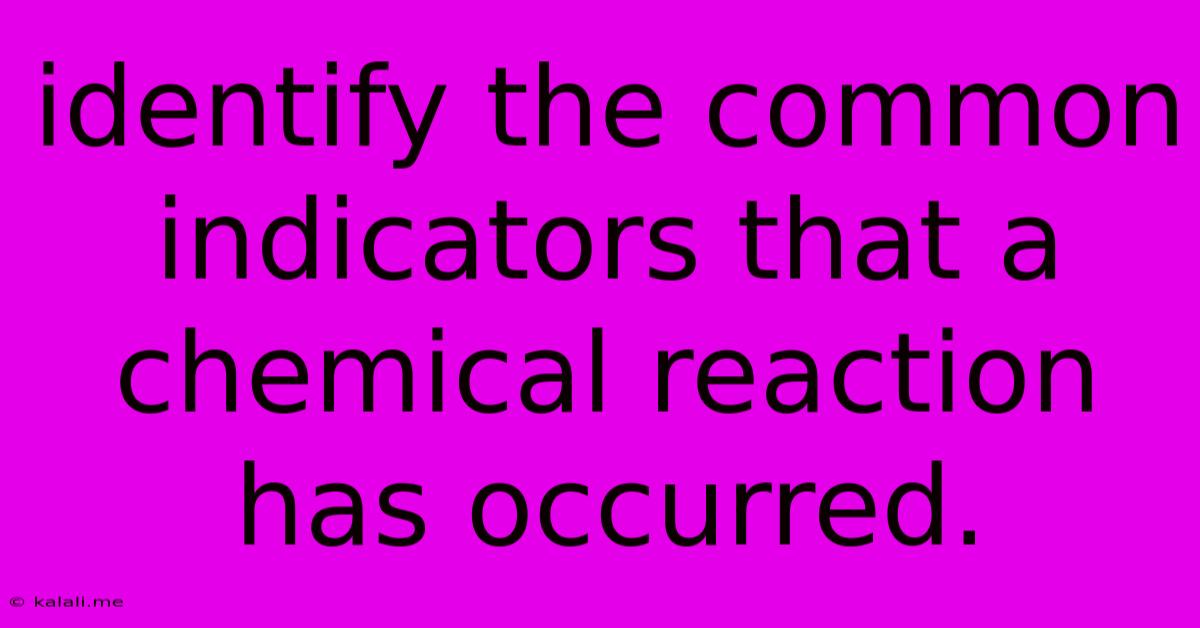Identify The Common Indicators That A Chemical Reaction Has Occurred.
Kalali
May 10, 2025 · 3 min read

Table of Contents
Identifying the Common Indicators That a Chemical Reaction Has Occurred
Chemical reactions are the foundation of our world, from the rusting of iron to the processes within our bodies. Understanding how to identify these reactions is crucial in various fields, including chemistry, biology, and even cooking. This article will explore several key indicators that signal a chemical reaction has taken place. Learning to recognize these signs will enhance your understanding of the dynamic world of chemistry.
What is a Chemical Reaction?
Before diving into the indicators, it's essential to understand what constitutes a chemical reaction. A chemical reaction involves the rearrangement of atoms to form new substances with different properties than the original substances. This rearrangement is often accompanied by observable changes.
Key Indicators of a Chemical Reaction:
Several observable changes can indicate that a chemical reaction has occurred. These are not mutually exclusive; often, multiple indicators are present simultaneously.
1. Change in Temperature:
One of the most common signs is a change in temperature. Exothermic reactions release energy in the form of heat, resulting in a temperature increase. Think of the heat generated when burning wood or the warmth from a hand warmer. Conversely, endothermic reactions absorb energy from their surroundings, leading to a decrease in temperature. Dissolving certain salts in water, for example, can cause a noticeable cooling effect.
2. Formation of a Precipitate:
A precipitate is a solid that forms from a solution during a chemical reaction. This is a visually striking indicator, as a cloudy or solid substance suddenly appears where there was previously a clear solution. The formation of a precipitate is often used in chemical analysis to identify specific ions.
3. Production of a Gas:
The release of a gas is another clear sign. This might be evident as bubbling, fizzing, or the formation of visible fumes. The classic example is the reaction between an acid and a metal carbonate, which produces carbon dioxide gas. Baking soda (sodium bicarbonate) reacting with vinegar (acetic acid) is a familiar example of this gas production.
4. Change in Color:
A change in color is a frequently observed indicator. Many reactions involve a shift in the absorption or emission of light by the substances involved. This could range from a subtle shift in hue to a dramatic color change. The oxidation of iron, resulting in rust, is a prime example of a color change signifying a chemical reaction. Consider also the vibrant color changes in many chemical indicator solutions used in titrations.
5. Change in Odor:
A change in odor, or the production of a new odor, can indicate a chemical reaction. Many reactions produce volatile compounds with distinctive smells. The familiar smell of rotten eggs is hydrogen sulfide gas, a product of certain chemical processes. The characteristic scent of freshly cut grass is the result of chemical reactions triggered by damage to plant cells.
6. Change in Properties:
Sometimes, the change may not be visually striking but involves a change in fundamental properties. For example, the reaction of an acid and a base produces a salt and water, leading to a neutral pH compared to the initial acidic and basic solutions. This altered pH, measured using indicators or pH meters, indicates a complete chemical change.
Conclusion:
Recognizing these indicators – temperature change, precipitate formation, gas production, color change, odor change, and altered properties – allows one to confidently identify that a chemical reaction has occurred. While each indicator offers valuable information, the presence of multiple indicators strongly supports the conclusion that a chemical transformation has taken place. Remember that these are common indicators and some chemical reactions might exhibit subtle or unusual changes. Careful observation and understanding are crucial for correctly interpreting the evidence.
Latest Posts
Latest Posts
-
How Much Is Three Quarts Of Water
Jul 03, 2025
-
How Tall Is A 3 Story Building
Jul 03, 2025
-
Is Miranda Cosgrove Related To Jimmy Fallon
Jul 03, 2025
-
What Is 1 4 Of A 1 4 Cup
Jul 03, 2025
-
What Is 20 Percent Off Of 39 99
Jul 03, 2025
Related Post
Thank you for visiting our website which covers about Identify The Common Indicators That A Chemical Reaction Has Occurred. . We hope the information provided has been useful to you. Feel free to contact us if you have any questions or need further assistance. See you next time and don't miss to bookmark.